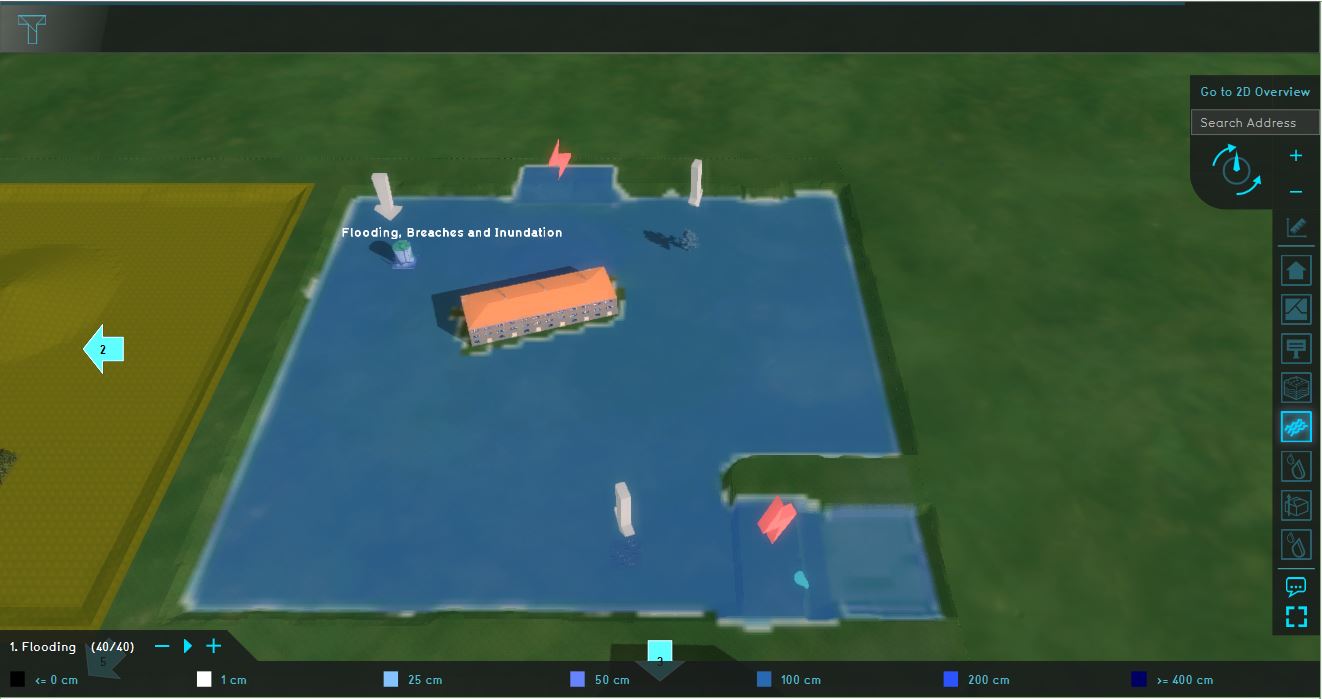Demo Watershed Project: Difference between revisions
Jump to navigation
Jump to search
| Line 13: | Line 13: | ||
[[File:Flooding_testbed.JPG|thumb|right|300px|Flooding, breaches and inundation]] | [[File:Flooding_testbed.JPG|thumb|right|300px|Flooding, breaches and inundation]] | ||
Boundary conditions and input | ====Boundary conditions and input==== | ||
# Click on the button Overlays and select the 'Gemalen' Overlay. Notice the highlighted areas under the grey water tap. These areas are two outlets, which remove water from the project. These areas are marked as [[Discharge_areas_result_type_(Watershed_Overlay)|discharge areas]] for the Watershed Module. | # Click on the button Overlays and select the 'Gemalen' Overlay. Notice the highlighted areas under the grey water tap. These areas are two outlets, which remove water from the project. These areas are marked as [[Discharge_areas_result_type_(Watershed_Overlay)|discharge areas]] for the Watershed Module. | ||
# Select the Peilgebieden Overlay and notice the two water level areas. | # Select the Peilgebieden Overlay and notice the two water level areas. | ||
| Line 20: | Line 20: | ||
# Take a look at the [[Surface_average_direction_result_type_(Water_Overlay)|Surface Average Direction result]] result type. The arrows show the average direction of the water. Notice that in the forest area, the arrows point inwards. | # Take a look at the [[Surface_average_direction_result_type_(Water_Overlay)|Surface Average Direction result]] result type. The arrows show the average direction of the water. Notice that in the forest area, the arrows point inwards. | ||
Results | ====Results==== | ||
# Take a look at the Watershed Overlay. This overlay shows the calculated watershed areas. Rainfall water that falls on the terrain, flows to the water terrains in the coloured areas. Notice that the forest area is not part of a watershed area, since the forest retains the water, as also shown in the [[Surface_average_direction_result_type_(Water_Overlay)|Surface Average Direction result]] result type. Notice that road area depcited dwith the question mark icon is also not part of the watershed area, since there are no culverts that connect the water terrains parallel with the road, with the other water terrains. | # Take a look at the Watershed Overlay. This overlay shows the calculated watershed areas. Rainfall water that falls on the terrain, flows to the water terrains in the coloured areas. Notice that the forest area is not part of a watershed area, since the forest retains the water, as also shown in the [[Surface_average_direction_result_type_(Water_Overlay)|Surface Average Direction result]] result type. Notice that road area depcited dwith the question mark icon is also not part of the watershed area, since there are no culverts that connect the water terrains parallel with the road, with the other water terrains. | ||
# Select the 'Uitstroomgebieden' overlay and notice that the initial discharge areas (see 'Gemalen' Overlay) are propagated with much more water terrains by the culverts (water connections). Zoom in to the edge of the two discharge areas and notice that the flow in the two culverts is opposite. | # Select the 'Uitstroomgebieden' overlay and notice that the initial discharge areas (see 'Gemalen' Overlay) are propagated with much more water terrains by the culverts (water connections). Zoom in to the edge of the two discharge areas and notice that the flow in the two culverts is opposite. | ||
| Line 26: | Line 26: | ||
====Analyze=== | |||
# Go to the Watershed Overlay and open the | # Go to the Watershed Overlay and open the Configuration wizard. In step 2, check the option Discharge remaining water and take note of the min area m2 option in the wizard. With this option selected, water terrains that are larger than the minimal area size of 1 m2 are now also taken into account as unique discharge areas. Click several times on Next in the wizard, until you can Finish the wizard. After reculculation, notice the area in the question mark has now also watershed areas. | ||
# Go to the culvert, highlighted by the ruler icon and click on the culvert icon. Set the Culvert_height on 2m. When the overlays are done calculating, go to the Watershed overlay and notice how the watershed areas have changed. | # Go to the culvert, highlighted by the ruler icon and click on the culvert icon. Set the Culvert_height on 2m. When the overlays are done calculating, go to the Watershed overlay and notice how the watershed areas have changed. Since the culvert does not connect all the water terrains and only the Uistroomgebieden where depicted as discharge areas, the water terrains are not part of the watershed areas anymore. | ||
More information on each component: | More information on each component: | ||
Revision as of 11:28, 15 June 2020
This page provides an overview and explanation about the Demo Watershed project, available for all users.
About the project
The project Demo Watershed is available for users with access to the Preview and can be found in the main menu under Edit projects. This project does not count for your license. In this project, several components of the Watershed module are visible. It can serve as a working demo to further explore the details of the available components, the used models and formulas and the configurable parameters.
Contents
The Demo Watershed project demonstrates the Watershed Overlay in a testbed setting.
Demo Watershed
Boundary conditions and input
- Click on the button Overlays and select the 'Gemalen' Overlay. Notice the highlighted areas under the grey water tap. These areas are two outlets, which remove water from the project. These areas are marked as discharge areas for the Watershed Module.
- Select the Peilgebieden Overlay and notice the two water level areas.
- Go to the Rainfall Overlay and play the Overlay. This overlay shows the Surface last value result type in where a heavy short rainfall was simulated. The orange icons are culverts, which connect the water terrains.
- Select the 'Terrain height' overlay and notice the forest area is much higher than the rest of the project area.
- Take a look at the Surface Average Direction result result type. The arrows show the average direction of the water. Notice that in the forest area, the arrows point inwards.
Results
- Take a look at the Watershed Overlay. This overlay shows the calculated watershed areas. Rainfall water that falls on the terrain, flows to the water terrains in the coloured areas. Notice that the forest area is not part of a watershed area, since the forest retains the water, as also shown in the Surface Average Direction result result type. Notice that road area depcited dwith the question mark icon is also not part of the watershed area, since there are no culverts that connect the water terrains parallel with the road, with the other water terrains.
- Select the 'Uitstroomgebieden' overlay and notice that the initial discharge areas (see 'Gemalen' Overlay) are propagated with much more water terrains by the culverts (water connections). Zoom in to the edge of the two discharge areas and notice that the flow in the two culverts is opposite.
- To highlight this, go to the Base types result type and see the Entry and Exit point of the culvert.
=Analyze
- Go to the Watershed Overlay and open the Configuration wizard. In step 2, check the option Discharge remaining water and take note of the min area m2 option in the wizard. With this option selected, water terrains that are larger than the minimal area size of 1 m2 are now also taken into account as unique discharge areas. Click several times on Next in the wizard, until you can Finish the wizard. After reculculation, notice the area in the question mark has now also watershed areas.
- Go to the culvert, highlighted by the ruler icon and click on the culvert icon. Set the Culvert_height on 2m. When the overlays are done calculating, go to the Watershed overlay and notice how the watershed areas have changed. Since the culvert does not connect all the water terrains and only the Uistroomgebieden where depicted as discharge areas, the water terrains are not part of the watershed areas anymore.
More information on each component:





